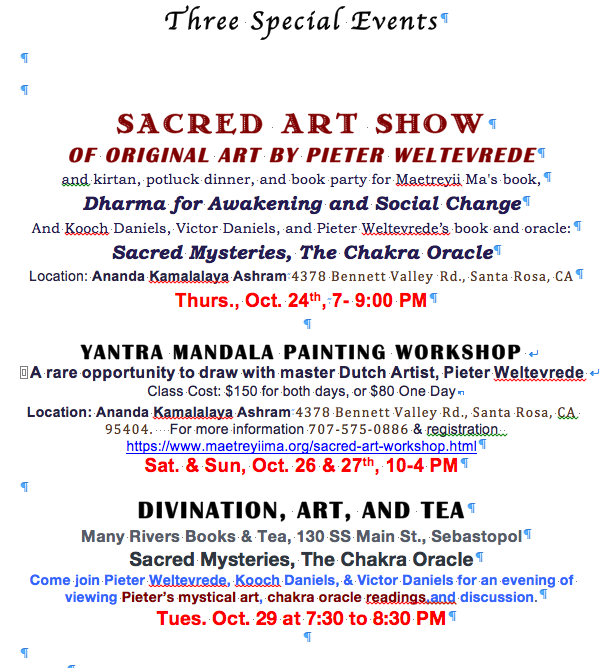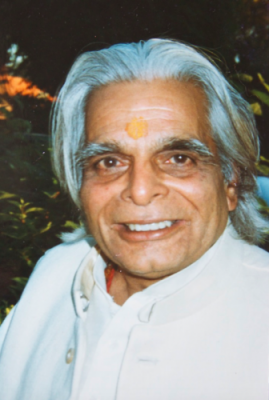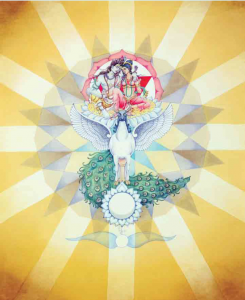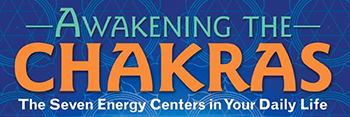
Thursday, Oct 17, 2019
PIETER WELTEVREDE IS HERE FROM HOLLAND! Saturday Oct. 19 at 6 PM he will be showing his recent paintings at the yoga studio in Bodega. The other three events, on the 24th, 26th-27th, and 29th are shown on the flyer in this post. On the 24th and 29th Kooch and Victor will also be talking about the Sacred Mysteries Oracle Deck and book.

Thursday, Jun 15, 2017
 Sri Harish Johari was our teacher about the chakras for twenty years until he left this mortal plane in 1999. Since then his daughter Seema has kindly welcomed us into the family home when we visit Haridwar. He was a temple artist, aryuvedic health practitioner, and jnana and tantric yogi. The Introduction and Chapter 1 of Awakening the Chakras tell more about this remarkable teacher who had such an influence on all three authors. Each chapter begins with a quotation from one of his numerous books, and his remarkable intelligence and personal qualities influenced us throughout our writing process. We hope we have done at least a little to advance his thinking and make the knowledge he passed on more widely accessible.
Sri Harish Johari was our teacher about the chakras for twenty years until he left this mortal plane in 1999. Since then his daughter Seema has kindly welcomed us into the family home when we visit Haridwar. He was a temple artist, aryuvedic health practitioner, and jnana and tantric yogi. The Introduction and Chapter 1 of Awakening the Chakras tell more about this remarkable teacher who had such an influence on all three authors. Each chapter begins with a quotation from one of his numerous books, and his remarkable intelligence and personal qualities influenced us throughout our writing process. We hope we have done at least a little to advance his thinking and make the knowledge he passed on more widely accessible.

Thursday, Jun 15, 2017
Why indeed? After all, it takes at least five minutes from your day, or better yet ten, or even more if you get deeply into it. First, you’ll probably get back that time. You’ll remember something important that you’ve left undone and will save a lot of time by doing sooner rather than later. Or you’ll realize that you can do an errand you were going to do today when you go out tomorrow, and save a whole trip to town or across town, Second, you’re likely to feel more relaxed and centered as you go through your day. Meditation helps you let go of physical and mental tension. Third, the odds are that you’ll think better. Meditation helps you clear away mental junk that gets in the way of giving your best attention to a task or problem. Fourth, you develop the ability to concentrate and to focus your attention. That makes it easier to perform a task well instead of poorly. It also lets you see when someone is taking a conversation where you don’t want it to go, and gently move it back onto what you think is important. Fifth, you develop your ability to be mindful of or to witness what you are doing with your own mind and emotions. (your choice of terms). Sixth, valuable unexpected insights can bubble up from your unconscious mind during meditation. Seventh, meditation creates a mental space in which you can become aware of troubling old memories or impulses and make your peace with them. AND LAST BUT NOT LEAST, THE MEDITATIVE APPROACHES AND TOOLS DESCRIBED IN “AWAKENING THE CHAKRAS” HELP YOU DEVELOP CAPACITIES AND WORK THROUGH PROBLEMS LINKED WITH EACH CHAKRA — AS WELL AS APPLYING THE MOST EFFECTIVE BALANCE OF CHAKRA ENERGIES TO YOUR PRESENT CONCERN.
Thursday, Jun 15, 2017

As a young man Harish Johari, a jnana yogi and aryuvedic practitioner who was the principal teacher about the chakras for all three authors, gave up his job as manager of a factory to become a yogi and artist. He did the murals on the walls of temples in northern India, created small paintings as well, and was also a sculptor. When he resigned as manager of the factory, his father told him he would have to gain a very broad and deep education “because an artist has to know everything.”
Johari developed a unique wash method of painting that involves many layers on top of each other, with a wash of an underlying layer before proceeding to the next one. He left behind a rich collection of his own paintings and drawings, and taught drawing and painting in India, Europe, and America. All three authors took his art classes, which required very precise geometrical measurements and also great creativity.
Just one of the three of us displayed a special talent for the work. That was Pieter Weltevrede from the Netherlands, who became Johari’s principal art student. Inspired by the master, he made painting his own life work. To date he has created hundreds of paintings. Some can be found in the center color section of Awakening the Chakras. These include a yantra (the visual equivalent of a mantra) for each of the seven chakras and two extra paintings for the seventh chakra, and also several other works. In the book he has also included a black-and-white line drawing of each painting in which it is easy to see the details of both the principal figures and the smaller symbols. This is followed by his explanation in the text of the traditional meaning of each one of these. ( Johari used to take Pieter to museums in India and point out what each of the symbols in the paintings and sculptures meant.) Victor comments, “I used to look at the classsical art of India briefly and think, ‘Oh, that’s nice,’ with especially lovely pictures–and then went on to the next one. Now I can actually understand what each of the elements of a painting means. Pieter’s work here has transformed my ability to look at Indian art.”
All the small icons and decorations in the book are also by Pieter.
Since Johari passed on in 1999, Pieter has continued to experiment with his medium and has developed unique artistic techniques that Victor and Kooch have never seen used by anyone else. Today he is one of the great living painters in the Indian classical tradition.
Each year Pieter travels to Europe and the U.S. with a selection of his original work and sells it in selected cities on both continents as well as in India. Reproductions of some of his work can be bought on the Sanatan Society website.
Thursday, Jun 15, 2017

counselor or psychotherapist & client
HOW UNDERSTANDING THE CHAKRAS CAN BE USEFUL FOR
A HUMAN SERVICES PRACTITIONER
THE HISTORY. In the past, knowledge of the chakras was used mainly within the context of spiritual development. Gurus and their followers sought to help people become more ethical, more caring with each other, more conscious of their own mental processes, and more blissful in their daily lives.
A SIMILIARITY TO MASLOW’S HIERARCHY OF NEEDS. Psychologist Abraham Maslow showed how his conception of a “hierarchy of needs,” has much in common with the chakra system, and can be useful in psychology and psychotherapy. But Maslow’s self-identification was as a humanistic and existential psychologist, a branch of the discipline that never quite made it into the psychological mainstream in the way that psychoanalysis, behavioral, and cognitive behavioral psychology did. Existential and humanistic approaches did make it into the psychotherapeutic mainstream in the work of Carl Rogers, and later Ervin Yalom, but Maslow’s work was not part of that. His hierarchy is mentioned in many introductory psychology texts (often with the misconception that Maslow viewed it as a pyramid, which was not the case), but then the texts go on to something else and seldom make any effective use of the Maslow’s hierarchy.
THE RUSSIAN TRANSPERSONAL TEACHER GEORGE GURDJIEFF referred to identifying a person’s “Chief Feature.” This is closely related to perceiving a person’s dominant chakra and how he or she uses it. But Gurdjieff emphasized a training program, whereas in Awakening we emphasize development of a highly differentiated individual awareness of not only the chief feature but also the qualities of each of the other chakras, of how their dynamics are causing a person problems, and of how to transform his or her thoughts, feelings, and even sensations in order to live a more secure, satisfying, and happier, life.
A CENTRAL ELEMENT IN BOTH CHAKRA WORK AND IN GESTALT THERAPY, COGNITIVE BEHAVIORAL PSYCHOLOGY, AND PSYCHOANALYSIS is the development of a capacity for moment-by-moment awarenss of a person’s inner dynamics and processes. This includes mind, body, emotions, and spirit. Among psychoanalysts, only Wilhelm Reich, and his followers such as Stanley Keleman, make physical sensations a central part of their work. Psychoanalysis emphasized the mind and emotions, but in a manner that included a measure of distance from them. The gestalt therapy that Fritz Perls and his colleagues created emphasized developing immediate moment-by-moment awareness in each moment of what a person is experiencing. Aaron Beck’s version of cognitive behavior therapy did something similar, asking patients to listen to what their inner voice was saying (such as thoughts about how the therapist might be viewing them) at the same time their outer voice and behavior might be saying something else.
THE CHAKRA SYSTEM ADDS TO THIS the “witness consciousness” or “mindfulness” element of direct self-awareness of the person’s own process of noticing what his or her thoughts, feelings, and bodily sensations are doing. A unique contribution lies in also providing a “map” that helps a human services professional or a client pinpoint dominant energies, and suppressed energies the client is likely to benefit from developing. This allows a faster zeroing-in on areas where problems and opportunities lie, and illuminates pathways for working on them that even most skilled therapists would otherwise require more time to trace out.
FINALLY, MOST THERAPY AND COUNSELING ARE ORIENTED TOWARD HELPING PEOPLE WHO FEEL TROUBLED. A common goal is to help clients become “normal.” That means like the norm, the average — i.e. no more or less screwed up than everybody else, so they can function in society. THE CHAKRA SYSTEM IS EXPLICTLY TRANSPERSONAL OR SPIRITUAL (your choice of terms.) It aspires to help people transcend many of the dilemmas of “normal” everyday life and develop a fuller, richer, deeper consciousness that leads in the directions of greater self-realization than most people ever achieve.
Thursday, Jun 15, 2017

WHAT AWAKENING THE CHAKRAS IS NOT:
It’s not a Hatha Yoga instruction book with photos or diagrams of asanas. Many shelves filled with good books already do that. So do plenty of websites. And you may even be taking a Hatha Yoga class in which your instructor shows you the asanas he or she wants you to do, demonstrates them, and has you do them together in a group –or individually. This book adds other very different dimensions that complement Hatha Yoga instruction.
JUST ONE HATHA YOGA TIP
We’d like to point out just one important item that many but not all instructors emphasize. That’s to sunchronize your movements with your breathing. The most basic form of this is inhaling during one half of a posture’s sequence of movement and exhaling during the other half, with a slow meditative consciousness throughout. Moment by moment, notice whatever you experience in you body, your emotions, and your mind. As you do, your yoga becomes also a meditation. You want to listen to your body and regulate your somatic processes so far as you can as you do your practice.
SOME ITEMS THAT YOU WON’T FIND IN THE BOOK OR ELSEWHERE ON THIS WEBSITE
You might wish to have a broader background for your yoga pactice and chakra studies. A number of different paths of self development are called yogas. “Yoga” means “union.” Union of the mind and body. Union of the personal self with the world and universe. Union with God. Union with the knowledge of the ages. You can find information about all this by combing the web, but that’s quite an undertaking. You might find it useful to begin with a 24-page moderately detailed description of Yogic ideas and practice. There’s a link to it at the end of this post. (It’s a copy of lecture notes for a presentation Victor gave his students at the university.) For openers here are a few highlights.
THE PRINCIPAL YOGAS ARE:
1. Hatha Yoga. You know what this is.
2. Raja Yoga (“the royal yoga”) is meant to focus and discipline the mind. Sometimes it is used as a a synonym for meditation.
3. Bhakti Yoga is the yoga of love and devotion. It includes identification with your spiritual teacher and cultivating loving kindness in your heart. It also includes practices meant to produce a state of ecstatic bliss (chanting, dancing, etc.) A goal of Bhakti Yoga in India is to see the divine in everyone and everything,
4. Karma Yoga is the yoga of action, charitable acts, selfless service or seva. It is dedication to the well-being of other people and beings on the basis of your own self-development.. Its attitude is one of fundamental equality with the person you are helping — not self-righteous self-congratulation about the good you are doing as you sneer at others who are doing less.
5. Jnana yoga is the yoga of knowledge and wisdom, trying to discover truth through reason, the intellect, and accumulated experience passed down through the years and ages.
6. Tantra Yoga, also called Kundalini Yoga, is influenced by Tibetan thought and is connected with worship of the divine as the Supreme Mother in any form she may assume. Its “left handed” and “right handed” paths are described in Awakening the Chakras.
7. Purna or Integral yoga is Sri Aurobindo’s 20th Century synthesis of India’s traditional yoga systems. It holds that active participation in life is needed to complement mental serenity and self-purification. The poet Tagore stresses finding freedom amid the interactions of relationships and society.
Not included among the seven yogas above, but considered one of the foundations of classical yoga philosophy, is the collection of YAMAS and NIYAMAS passed down fom the 2nd century BCE teacher Patanjali. His YOGA SUTRAS are the most complete systematization of India’s spiritual literature and India’s central guide to ethics. (In the gold-colored illustration at the top left of each page of this website, you can see Patanjali seated on the coils of a cobra with the OM symbol behind him.)
LEARN MORE about all seven yogas, the history of yoga, and central themes in yogic philosophy and psychology in this pdf link.
(To read “Learn More” online, Chrome & Safari work fine. Firefox do not open it for online reading but will download it and you can read the download.)
Thursday, Jun 15, 2017

This page describes how understanding and using your chakra energies effectively can benefit varied aspects of your daily life.
If you’re not a yogic practitioner, a client in therapy or counseling, or a spiritual seeker, does this book hold any value for you?
For openers, it can serve as an attractive coffee table book. Your visitors will probably enjoy the lovely illustrations. But of course there’s more.
It can a help you answer the question, “Now why did I do that?” when you’re confused about your motives and acted in a way you wouldn’t have expected.
It can give you a “road map” of your main motives and their variations. You’ll know in advance what you’re most likely to do in various situations.
There are everyday awareness practices that can help you be more present, centered and focused in what you do.
You’ll probably get better at assessing what drives another person. This can give you valuable clues about what he or she is apt to do in various situations. And clues about what the person is likely to resist or avoid doing.
Since you’ll probably get better at seeing and hearing what others want and need, and at helping them get those things, others will tend to be happier interacting with you. That’s also likely to improve your relationships.
And since you’ll know your own motives better, you’ll less often feel like you have to be “the big shot” in ways that make others feel small. That has many added benefits.
Also, you won’t ever have to be bored again. When you’re waiting for someone, or for an appointment, instead of twiddling your thumbs you’ll have a whole spectrum of mini-meditations and awareenss practices you can choose from to keep you interested and occupied.
If you’d like a deeper understanding of your own inner world, these chapters “turn on the lights” in the chambers of your lesser-known neural pathways. They can help you find out things about yourself you never knew before–or once knew but conveniently or inconveniently forgot.
And of course there are the biggies. Better mental balance and self-composure. Greater peace of mind. More effective action. Fewer mistakes. Less wasted effort. And probably more satisfaction with your life as it IS, instead of making yourself unhappy because it isn’t different. In short, just plain more everyday success and happiness.
If all this isn’t enough, you can have a look at the pages on this website titled WHAT’S IN THIS FOR YOU? and WHAT’S NEW AND UNIQUE HERE.
We hope you join us on this journey. If so, WELCOME!



 Sri Harish Johari was our teacher about the chakras for twenty years until he left this mortal plane in 1999. Since then his daughter Seema has kindly welcomed us into the family home when we visit Haridwar. He was a temple artist, aryuvedic health practitioner, and jnana and tantric yogi. The Introduction and Chapter 1 of Awakening the Chakras tell more about this remarkable teacher who had such an influence on all three authors. Each chapter begins with a quotation from one of his numerous books, and his remarkable intelligence and personal qualities influenced us throughout our writing process. We hope we have done at least a little to advance his thinking and make the knowledge he passed on more widely accessible.
Sri Harish Johari was our teacher about the chakras for twenty years until he left this mortal plane in 1999. Since then his daughter Seema has kindly welcomed us into the family home when we visit Haridwar. He was a temple artist, aryuvedic health practitioner, and jnana and tantric yogi. The Introduction and Chapter 1 of Awakening the Chakras tell more about this remarkable teacher who had such an influence on all three authors. Each chapter begins with a quotation from one of his numerous books, and his remarkable intelligence and personal qualities influenced us throughout our writing process. We hope we have done at least a little to advance his thinking and make the knowledge he passed on more widely accessible.



